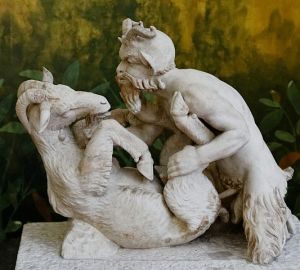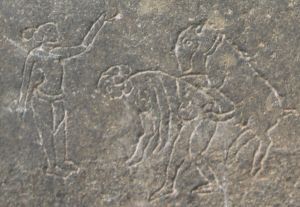History of zoophilia
The history of zoophilia (also known as bestiality) begins in the prehistoric era, where depictions of humans and animals in a sexual context appear infrequently in European rock art.[1] Bestiality remained a theme in mythology and folklore through the classical period and into the Middle Ages (e.g. the Greek myth of Leda and the Swan)[2] and several ancient authors purported to document it as a regular, accepted practice – albeit usually in "other" cultures.
Explicit legal prohibition of human sexual contact with animals is a legacy of the Abrahamic religions:[2] the Hebrew Bible imposes the death penalty on both the person and animal involved in an act of bestiality.[3] There are several examples known from medieval Europe of people and animals executed for committing bestiality. With the Age of Enlightenment, bestiality was subsumed with other sexual "crimes against nature" into civil sodomy laws, usually remaining a capital crime.
Bestiality remains illegal in most countries and condoned in none. Though religious and "crime against nature" arguments may still be used to justify this, today the central issue is the ability of non-human animals to give consent: it is argued that sex with animals is inherently abusive.[4] In common with many paraphilias, the internet has allowed the formation of a zoophile community that has begun to lobby for zoophilia or zoosexuality to be considered an alternative sexuality and for the legalisation of bestiality.[5]
Prehistory
Depictions of human sexual activity with animals appear infrequently in prehistoric art. Possibly the oldest depiction, and the only known example from the Palaeolithic (prior to the domestication of animals), is found in the Vale do Côa in Portugal. It shows a man with an exaggerated, erect penis juxtaposed with a goat. However, there is some doubt that the two figures are contemporary; while the goat is depicted in characteristic palaeolithic style, the scene may have been altered in a later period with the insertion of the human figure.[6]
From the Neolithic onwards, images of zoophilia are slightly more common. Examples are found at Coren del Valento, a cave in Val Camonica, Italy, containing rock art dating from 10,000 BCE to as late as the Middle Ages, one depicting a man penetrating a horse,[7] and Sagaholm, a Bronze Age cairn in Sweden where several petroglyphs have been found with similar scenes.[8]
Classical antiquity


Several Greek myths include the God Zeus seducing or abducting favoured mortals while in the form of an animal: Europa and the bull, Ganymede and the eagle, and Leda and the Swan.[2] Only the latter legend includes actual copulation between Lena and Zeus in his animal form, but depictions of this act, fairly uncommon in antiquity, became a popular motif in classicising Renaissance art, contributing to a lasting prominence in Western culture.[9]

Various classical writers recorded that bestiality was common in other cultures. Herodotus was followed by Pindar, Strabo and Plutarch[citation needed] in alleging that Egyptian women engaged in sexual relations with goats for religious and magical purposes - the animal aspects of Egyptian deities being particularly alien to the Greco–Roman world.[10][11] Conversely, Plutarch and Virgil make similar accusations of the Greeks, with Plutarch writing in his Discourse on the Reason of Beasts that they committed "very frequently and in many places great outrages, disorders and scandals against nature, in the matter of this pleasure of love; for there are men who have loved she-goats, sows and mares."
Despite their place in mythology and literature, actual acts of bestiality was probably as uncommon in antiquity as they are today.[2] Roman civil law, however, made no mention of it.[12] The explicit prohibition of and strict penalties for zoophilia universal in later European legal systems were derived from Jewish and Christian tradition.[2] The Hebrew Bible imposes the death penalty on both the human and animal parties involved in an act of bestiality: "if a man has sexual relations with an animal, he shall be put to death; and you shall kill the animal."[13] The Synod of Ancyra in 313–316 discussed the position of the church with regard to bestiality at length and two of the resulting twenty-five canons addressed it: the sixteenth canon described the penance and level of restrictions to be applied to various age groups for committing bestiality; the seventeenth canon prohibited all lepers from praying inside church if they had committed bestiality while they suffered from leprosy.[14]
Europe: Middle Ages
In the Church-oriented culture of the Middle Ages, zoosexual activity was met with execution, typically burning, and death to the animals involved either the same way or by hanging. Masters comments that:
- "Theologians, bowing to Biblical prohibitions and basing their judgements on the conception of man as a spiritual being and of the animal as a merely carnal one, have regarded the same phenomenon as both a violation of Biblical edicts and a degradation of man, with the result that the act of bestiality has been castigated and anathematized [...]"
In 1468, Jean Beisse, accused of bestiality with a cow on one occasion and a goat on another, was first hanged, then burned. The animals involved were also burned. In 1539, Guillaume Garnier, charged with intercourse with a female dog (described as "sodomy"), was ordered strangled after he confessed under torture. The dog was burned, along with the trial records which were "too horrible and potentially dangerous to be permitted to exist" (Masters). In 1601, Claudine de Culam, a young girl of sixteen, was convicted of copulating with a dog. Both the girl and the dog were first hanged, and finally burned. In 1735, François Borniche was charged with sexual intercourse with animals. It was greatly feared that "his infamous debauches may corrupt the young men." He was imprisoned, and there is no record of his release.
On the other hand, other accounts are more possibly fictitious, such as Pietro Damiani's, who in his "De bono religiosi status et variorum animatium tropologia" (11th Century) tells of a Count Gulielmus whose pet ape became his wife's lover. One day the ape became "mad with jealousy" on seeing the count lying with his wife that it fatally attacked him. Damain claims he was told about this incident by Pope Alexander II and shown an offspring claimed to be that of the ape and woman. (Illustrated Book of Sexual Records)
Clergyman and chronicler Gerald of Wales claimed to have witnessed a man having intercourse with a horse as part of a pagan ritual in Ireland.[15][16]
Although thousands of female witches were accused of having sex with animals, usually said to be the Devil in animal form or their familiars, court records available in Europe and the United States, dating back to the 14th century and continuing into the 20th century, nearly always show males, rather than females, as the human parties in court cases. (Encyclopedia of human sexuality, Humboldt University)
See also
References
- ↑ Bahn, Paul G. (1998). The Cambridge illustrated history of prehistoric art. Cambridge: Cambridge University Press. p. 188. ISBN 978-0-521-45473-5. Retrieved 18 February 2012.
- ↑ 2.0 2.1 2.2 2.3 2.4 Cornog, M.; Perper, T. (1994). "Bestiality". In Haeberle, E. J.; Bullough, B. L.; Bullough; B. (eds.). Human Sexuality: An Encyclopedia. New York & London: Garland. Retrieved 18 February 2012.
- ↑ Leviticus 20:15
- ↑ Regan, Tom. Animal Rights, Human Wrongs. Rowman & Littlefield, 2003, pp. 63-4, 89.
- ↑ Francis, Thomas (20 August 2009). "Those Who Practice Bestiality Say They're Part of the Next Sexual Rights Movement". Broward Palm Beach New Times. Retrieved 18 February 2012.
- ↑ Angulo Cuesta, J.; García Diez, M. (2006). "Diversity and meaning of Palaeolithic phallic male representations in Western Europe". Actas Urol Esp. 30 (3): 254–267.
- ↑ Anati, E. (2008). "The Way of Life Recorded in the Rock Art of Valcamonica" (PDF). Adoranten. Scandinavian Society for Prehistoric Art (2008).
- ↑ "Sagaholm". On the rocks. Retrieved 18 February 2012.
- ↑ Bull, M. (2005). The Mirror of the Gods, How Renaissance Artists Rediscovered the Pagan Gods. Oxford: Oxford University Press. ISBN 0-19-521923-6.
- ↑ Ray, J. D. (2002). "Animal Cults". In Redford, D. B. (ed.). The Ancient Gods Speak: A Guide to Egyptian Religion. Oxford: Oxford University Press. p. 90. ISBN 978-0-19-515401-6.
{{cite book}}:|access-date=requires|url=(help) - ↑ Leavitt, J. (1992). "The Cults of Isis among the Greeks and in the Roman Empire". In Bonnefoy, Y. (ed.). Greek and Egyptian Mythologies. Chicago, IL: University of Chicago Press. p. 248. ISBN 978-0-226-06454-3.
- ↑ Norton, R. "Of Sodomy and Bestiality". Homosexuality in Eighteenth-Century England: A Sourcebook. Retrieved 18 February 2012.
- ↑ Leviticus 20:15
- ↑ "THE COUNCIL OF ANCYRA, HISTORICAL NOTE & CANONS". Retrieved 18 February 2012.
- ↑ Last Night's Television: Always let a sleeping pagan lie
- ↑ Banks-Smith, Nancy (July 20, 2004). "Please, please tell me now". The Guardian. London. Retrieved May 4, 2010.
Further reading
- Marie-Christine Anest: Zoophilie, homosexualite, rites de passage et initiation masculine dans la Greece contemporaine (Zoophilia, homosexuality, rites of passage and male initiation in contemporary Greece) (1994), ISBN 2-7384-2146-6
- Dubois-Dessaule: Etude Sur la Bestiality au point de Vue Historique (The Study of Bestiality from the Historical, Medical and Legal Viewpoint) (Paris, 1905)
- Gaston Dubois-Desaulle: Bestiality: An Historical, Medical, Legal, and Literary Study, University Press of the Pacific (November 1, 2003), ISBN 1-4102-0947-4 (Paperback Ed.)
- Hans Hentig Ph.D.: Soziologie der Zoophilen Neigung (Sociology of the Zoophile Preference) (1962)
- Bronisław Malinowski:
The Trobriand Islands (1915)
The Sexual Life of Savages in North-Western Melanesia (1929) - Robson, Bestiality and Bestial Rape in Greek Myth, 1997, S. Deacy and K. F. Pearce (edd.), Rape in Antiquity, Duckworth, 65-96
- Voget, F. W. (1961) Sex life of the American Indians, in Ellis, A. & Abarbanel, A. (Eds.) The Encyclopaedia of Sexual Behavior, Volume 1. London: W. Heinemann, p90-109
- Pages with numeric Bible version references
- CS1 errors: access-date without URL
- All articles with unsourced statements
- Articles with unsourced statements from February 2012
- Articles with invalid date parameter in template
- Articles with hatnote templates targeting a nonexistent page
- Zoophilia
- Zoophilia in culture